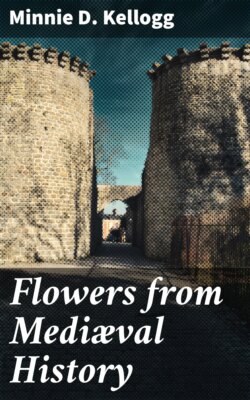Читать книгу Flowers from Mediæval History - Minnie D. Kellogg - Страница 3
На сайте Литреса книга снята с продажи.
Advertisement
ОглавлениеTable of Contents
These accounts all relate to places and objects that the uncommercial traveler may casually run upon at some turn of his way. Subjects mentioned in Baedeker have been considered here reflectively rather than descriptively. Although I do not propose to analyze the soil in which these flowers of history have sprung up, nor to speak of the rank weeds growing by their sides, I have tried not to blight these blossoms with falsehood. Certainly one-half of the truth is as true as the other and it may be infinitely pleasanter. As far as they go, these little historiettes are based upon evidence and authority.
I want to teach you so much history that your sympathy may grow continually wider and you may be able to realize past generations of men just as you do the present, sorrowing for them when they failed, triumphing with them when they prevailed; for I find this one conviction never changing with me but always increasingy that one cannot live a life manfully without a wide world of sympathy and love to exercise it in.
—Burne-Jones to His Son.
Suggested itineraries for cathedral trips in Normandy, giving monuments of the first order only, places readily reached by rail:
First. Land at Bologne sur Mer, Amiens, Laon, Rheims, Paris, Saint Denis, Chartres, Caen, Bayeux, Mt. San Michele, embark from Cherbourg.
Second. Land from England at Dieppe, or from America at Havre, proceed to Rouen, which possesses the most perfect example of later Gothic in the great abbatical Church of Saint Ouen; an excellent example of flamboyant Gothic in Saint Maclou; and a large, irregular but imposing Gothic cathedral on the order of Rheims; thence to Mt. San Michele, most unique of mediæval monuments; thence to Caen and Bayeux near by it, Chartres and Paris. Amiens and Rheims being very similar, and on the order of Chartres and Notre Dame of Paris, are not included in this itinerary. The traveler to whom time is money will be greatly tried by the connections made and lost by the trains in Normandy that stop at small places. Both these itineraries respect the idiosyncrasies of French railroads.
The motorist, rejoicing in the excellent Norman roads, can combine these itineraries very easily—taking in the cathedrals of Le Mans, Bourg, Beauvais and Coutances. I would especially call his attention to the small but interesting Early Norman church at Dols, and to the walled town of San Malo on the sea, with picturesque little Dinan, fashionable Dinard, and a dirty little fishing village near by.
